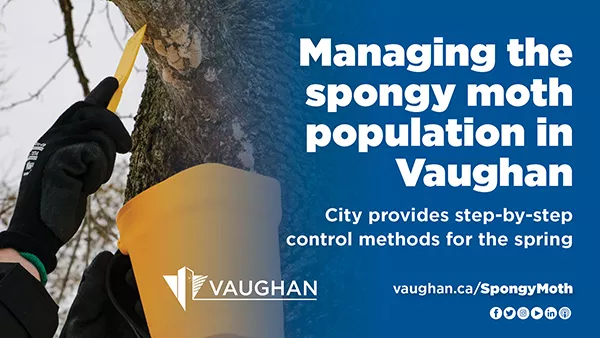Managing the spongy moth population in Vaughan
Have you checked the trees on your property for brown- and
orange-coloured egg masses? In May, you may start to see some of these egg
masses hatch into caterpillars. These insects are called spongy moths, formerly
known as LDD or gypsy moths, an invasive species not
native to Ontario. City of Vaughan staff continue working to manage the spongy
moth population in the community – and you can help!
Did you know, in the caterpillar stage of their life cycle, spongy moths eat leaves from hardwood trees such as oak, maple, birch and poplar, and select shrubs? While forested areas in York Region may be affected, trees in urban areas – including on local and regional roads and on private property – are most at risk. Soil compaction, air pollution and other pests and diseases make trees in urban areas more susceptible to infestation. However, affected trees that are healthy will usually grow a second crop of leaves in the same season.
What residents can do
To help protect trees on your property from these invasive insects, the following precautions can be taken this time of year:
- In April: Scrape off and destroy egg masses by submerging them in a bucket of soapy water for at least two days. After that time, discard the solution and egg mixture in the garbage. Doing this will help prevent more caterpillars from hatching in the future.
- Ensure you always wear gloves when handling caterpillars and egg masses to avoid an allergic reaction. It is important to look thoroughly on your property for egg masses as they can also be found on benches, firewood, outdoor furniture, swing sets and under the eaves of buildings.
- From May to June: Apply biological control products to affected trees early in the season to reduce infestations. Contact a licensed tree care company to discuss options for using these products as there is a very tight timing window.
What the City is doing
City staff began inspections of more than 2,000 City-owned trees in April throughout heavily infested areas. Staff have effectively removed egg masses from more than 1,100 trees so far this season. The City will continue to implement the following control measures throughout 2022:
- From January to May: The City is manually removing accessible egg masses through scraping and vacuuming in identified moth hot-spot areas.
- In May: The City will apply some Btk sprays (a biological control product that is non-toxic to animals, humans, plants and most other insects) from the ground at select park and street tree locations and will inject TreeAzin™ (a biological control product) in trunks of select high-value heritage trees. The City will also begin to install barrier bands on select high-value street and park trees in May.
City staff continue to track locations of outbreaks to inform potential next steps. Watch this video for more information on spongy moths.
For more information and links to resources, visit vaughan.ca/SpongyMoth, the Ministry of Agriculture, Food and Rural Affair’s webpage or york.ca/LDDMoth.
For updates and news as they happen, subscribe to Vaughan News and follow the official corporate channels on Twitter, Facebook, Instagram and LinkedIn.
-30-

